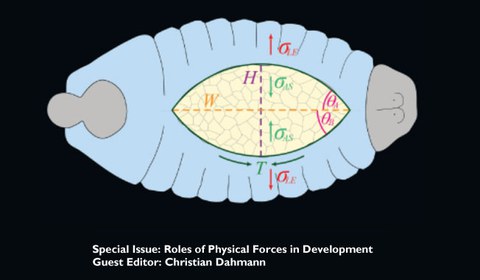22.03.2017
April 2017 Veröffentlichung der Spezialausgabe von "Mechanisms of Development" mit dem Titel: "Roles of Physical Forces in Development"
MoD Special Issue on the roles of physical forces in animal development
Christian Dahmann1
1 Institute of Genetics, Technische Universität Dresden, 01062 Dresden, Germany
D’Arcy Thompson, in his famous book “On Growth and Form” published a hundred years ago, set out to explain the ‘physical considerations’ underlying the form of living things (Thompson, D.W., 1917, On Growth and Form, University Press, Cambridge). He realized that biological processes abide physical laws, yet these laws until today remain largely unknown. The advent of molecular biology had diverted the interest of developmental biologists away from the physical principles towards the analysis of genes and proteins in embryos. As a result, the past decades have witnessed a tremendous advancement in our understanding of the genetic control of animal and plant development. The recent years, however, have seen a renewed interest in ‘developmental mechanics’ - the role of mechanical properties and physical forces in animal development. Enabled by latest advances in microscopy techniques, the ability to measure and manipulate physical forces in embryos, and computational approaches, biologists, in close collaboration with physicist, mathematicians and computer scientists, have begun nowadays to explore the physical principles of animal development. This Special Issue on ‘Roles of physical forces in animal development’ covers in ten reviews some of the current research areas where the analysis of physical forces has contributed to our understanding of developmental processes.
As we know today, the control of size and shape of embryos requires the spatiotemporal coordination of mechanical processes, including the shaping, division, migration, positioning and apoptosis of cells. These processes to a large extent depend on the cell’s cytoskeleton, but also on its adhesive contacts with neighboring cells and the extracellular matrix. In particular, the molecular interaction of motor proteins with actin filaments generates forces that can lead to cellular constrictions that, if coordinated, can give rise at a larger scale to tissue deformations including elongation, furrowing or folding. In addition to the activity, the organization of the cytoskeleton itself can be coordinated among cells, giving rise to supra-cellular structures like actomyosin cables that can generate tensile forces. Forces not only influence the cells that generate them, but often also impact on the behavior of neighboring cells.
The first four reviews by Hayes and Solon, Kong et al., de la Loza and Thompson, and Ambrosini et al. illustrate how the coordination of multiple intrinsic and extrinsic physical forces can orchestrate the shaping of epithelial tissues during different developmental processes. The review by Zulueta-Coarasa and Fernandez-Gonzalez then provides insights in the role of forces in the context of wound repair. Cells can sense the mechanical properties and physical forces of their environment and respond to it by chemical signaling, for example by activating growth or differentiation promoting signaling pathways. The review by Eder et al. illustrates this mechanical feedback in the context of growth control, drawing on examples from remodeling of bones as well as size control of epithelia. The interplay between mechanical forces shaping embryos and chemical signals guiding cell differentiation is also central for the formation of the anteroposterior axis in mouse embryos, as reviewed by Matsuo and Hiramatsu. The review by Ferreira and Vermot then discusses the different forces that lead to left-right patterning and asymmetric morphogenesis in embryos. Adhesive forces play a crucial role in cell sorting and Winklbauer and Parent review this topic in the context of amphibian development. Finally, Lemke and Schnorrer discuss the role of physical forces in the self-organization of myofibrils during muscle development.
These reviews highlight the impact of physical forces during animal development and illustrate the diversity of developmental processes in which physical forces are involved.
I would like to thank all contributing authors and the editorial team of Mechanisms of Development for their excellent work.
© 2017 Published by Elsevier Ireland Ltd.

